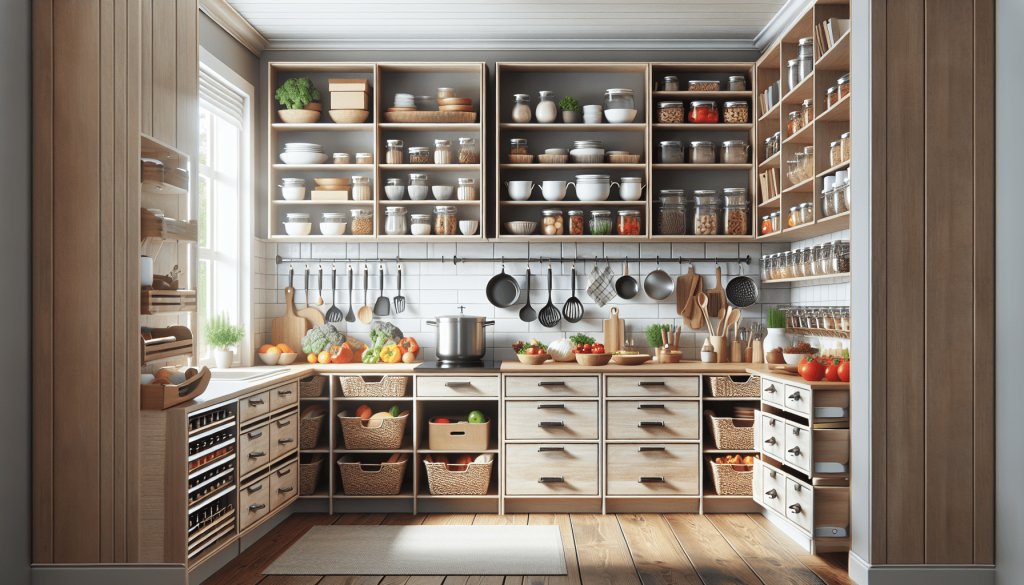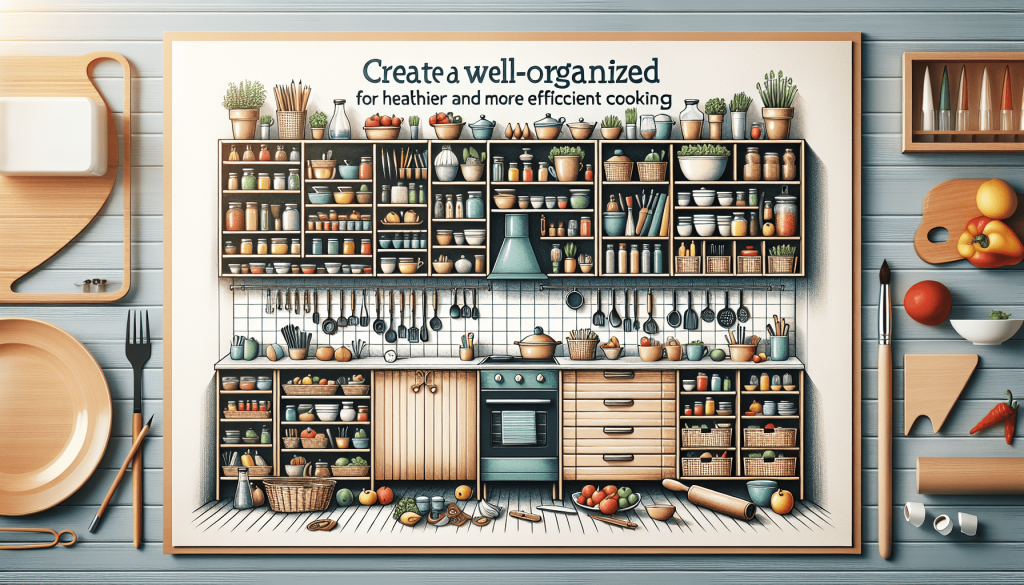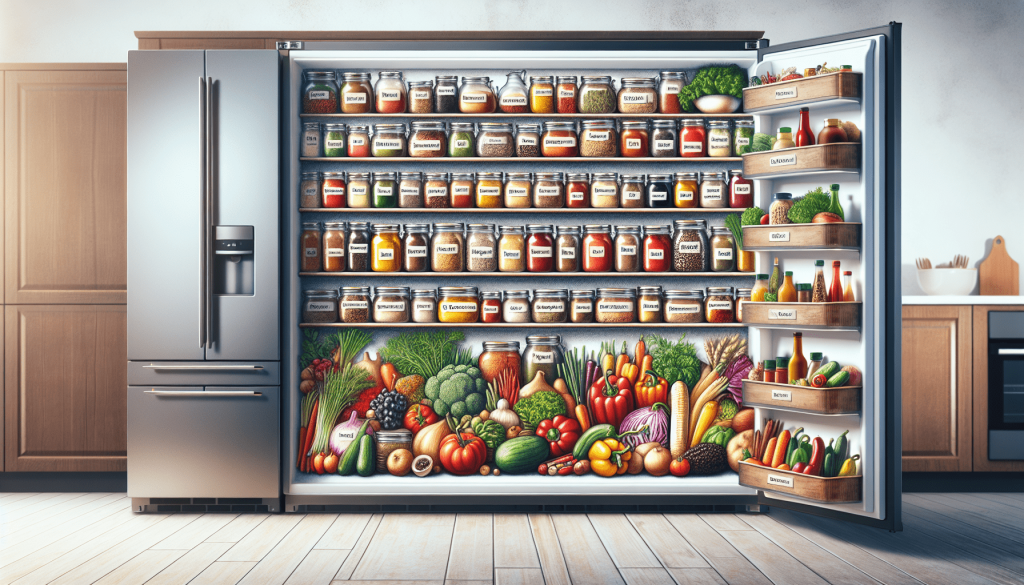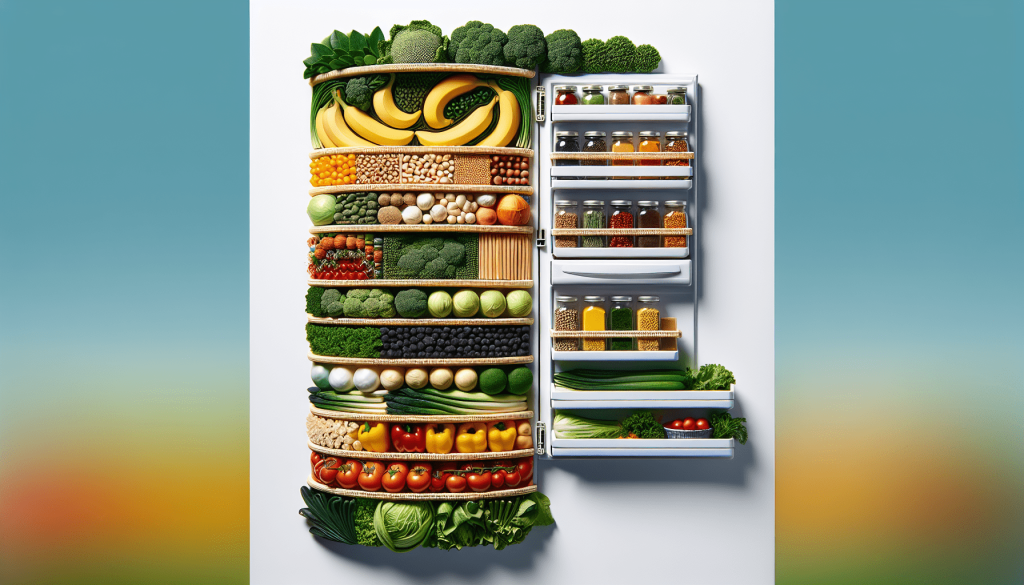You’ve finally decided to take the plunge and revamp your kitchen for healthy and efficient cooking. But where do you start? With a myriad of pots, pans, utensils, and ingredients, it can feel overwhelming to create an organized and functional space. Fear not, because in this article, we will provide you with practical tips and tricks to effectively organize your kitchen, ensuring that you not only cook nutritious meals but also do so with ease and efficiency. So put on your apron and get ready to transform your kitchen into a harmonious haven of culinary delight!
1. Declutter Your Kitchen
The first step to organizing your kitchen for healthy and efficient cooking is decluttering. Start by getting rid of unnecessary items that are taking up valuable space in your kitchen. Donate or sell any appliances, dishes, or utensils that you no longer use or need. This will clear out space and make it easier to find and access the items you do use regularly.
Next, focus on organizing your pantry. Take the time to go through your pantry and check the expiration dates of all your food items. Get rid of anything that is expired or no longer safe to consume. Consider donating any unexpired items that you know you won’t use. Once you’ve cleared out the clutter, organize your pantry by grouping similar items together. Keep cereals, grains, and baking supplies on one shelf, and canned goods on another. Use clear containers to store items like flour and sugar, which makes it easier to see what you have and when you need to restock.
The same goes for your fridge and freezer. Clear out any expired or spoiled food and wipe down the shelves and drawers. Group similar items together so that you can easily find what you’re looking for. Consider investing in clear containers for storing leftovers and other items. This will not only make it easier to see what’s inside, but it will also help to keep your fridge and freezer organized and prevent food waste.
2. Create Zones in Your Kitchen
Creating distinct zones in your kitchen will help you to efficiently navigate the space and make the cooking process smoother. Start by designating a prep area near your cutting board. This is where you’ll do all your chopping, slicing, and dicing. Make sure to have all your knives, cutting boards, and other essential prep tools within reach.
Next, set up a cooking area near your stove. This is where you’ll do all your cooking and simmering. Keep your pots, pans, and cooking utensils within easy reach for convenience and efficiency.
Lastly, organize your storage areas. Keep your pots and pans near the stove for easy access. Group like-items together and use dividers or organizers to keep everything tidy. Consider using clear, stackable containers for storing smaller items like spices and herbs. This way, you can easily see what you have and prevent duplicates.

3. Arrange Your Utensils and Tools
Having your utensils and tools organized and easily accessible is crucial for efficient cooking. Start by grouping similar items together, such as all your measuring spoons or spatulas. This will make it easier to find what you need when you’re in the middle of cooking.
Consider organizing your utensils by frequency of use. Place the items you reach for most often, like your favorite spatula or whisk, in a container near your stove. This way, you won’t have to dig through drawers or cabinets while you’re cooking.
Drawer organizers are a great way to keep small tools and gadgets organized. Use them to separate your measuring cups, zesters, and other small tools. This way, everything will have its place and be easy to find when you need it.
4. Store Ingredients Properly
Storing your ingredients properly will not only help to keep your kitchen organized, but it will also ensure that your food stays fresh and safe to eat. Start by labelling and dating your pantry items. This will help you keep track of when things were opened and when they need to be used by. Use clear containers for easy visibility, so you can quickly see what you have and when you need to restock.
When it comes to storing grains, nuts, and seeds, opt for airtight containers. This will help to keep them fresh and prevent pests from getting into your food. Investing in good quality containers will not only help with organization, but it will also ensure that your ingredients stay fresh for longer.

5. Set Up an Efficient Workflow
An efficient layout and workflow in your kitchen will save you time and make the cooking process much smoother. Start by arranging your kitchen in a functional layout. Keep your prep area near your cutting board and sink, with all your essential tools within easy reach. Your cooking area should be set up near your stove, with all your pots, pans, and cooking utensils readily available.
Keep commonly used items within reach to minimize unnecessary movement. This includes spices, oils, and frequently used utensils. Organize your kitchen in a way that makes sense to you and allows you to move through the cooking process without obstacles.
Consider creating designated stations for each step of the cooking process. For example, have a designated area for peeling and chopping vegetables, another area for seasoning and marinating, and a separate area for plating and garnishing. This way, you can move seamlessly from one step to the next without getting overwhelmed or disorganized.
6. Maintain a Clean and Sanitary Kitchen
A clean and sanitary kitchen is essential for healthy cooking. Make it a habit to wipe down surfaces regularly to prevent the build-up of dirt and bacteria. This includes countertops, stovetops, and sinks. Use a non-toxic cleaner or a mixture of vinegar and water for an eco-friendly option.
Cleaning as you go while cooking will also help to keep your kitchen clean and organized. Wash dishes, utensils, and cutting boards as you finish using them to prevent clutter and minimize time spent on cleaning up afterwards.
In addition to regular cleaning, create a schedule for deep cleaning tasks. This can include cleaning your oven, refrigerator, and other appliances. Set aside specific times each month to tackle these tasks so that they don’t become overwhelming.

7. Organize Your Meal Planning and Recipes
Meal planning is a great way to stay organized and ensure that you have healthy meals ready to go. Create a meal planning system that works for you, whether it’s a physical planner or a digital app. Dedicate some time each week to plan out your meals, taking into consideration your schedule and any dietary restrictions.
Organize and categorize your recipes so that you can easily find what you’re looking for. Whether you prefer a recipe box, a binder, or a digital recipe organizer, find a system that works for you. Sort your recipes into categories like breakfast, lunch, dinner, or by cuisine type. This will make it easier to plan meals and find recipes when you need them.
Utilize digital tools for meal planning and recipe storage. There are many apps and websites available that can help you organize your meal plans, generate shopping lists, and store your favorite recipes. Take advantage of these tools to streamline your meal planning and make healthy cooking even easier.
8. Utilize Vertical Space
When it comes to kitchen organization, don’t forget about vertical space. Installing shelves or racks on your walls can provide valuable storage space for items like cookbooks, pots, and pans. This not only frees up cabinet space but also adds a decorative touch to your kitchen.
Hooks or pegboards are another great way to utilize vertical space. Hang your most frequently used utensils, pots, and pans for easy access. This not only keeps your kitchen organized but also adds a stylish and functional element to your space.
Maximize your cabinet space with stacking shelves. These can be used to create additional levels within your cabinets, allowing you to store more items without taking up extra space. This is especially useful for storing plates, bowls, and containers.

9. Label and Sort Food Containers
Food containers can easily become a mess in your kitchen if not properly organized. Labeling containers with contents and expiration dates will help you quickly identify what’s inside and when it needs to be used. This will prevent any confusion and reduce food waste.
Sort containers by size and purpose. Keep similar sizes together, making it easier to stack and store. Separate containers for different purposes, such as meal prep containers, leftovers, and lunch containers, to keep things organized and easily accessible.
Invest in reusable and stackable containers. These will not only save you money on disposable containers but also help to keep your kitchen organized. Stackable containers take up less space and make it easier to find matching lids.
10. Maintain an Inventory System
To ensure that you always have the ingredients you need, it’s important to maintain an inventory system. Keep track of pantry and freezer items by regularly updating a list. This can be done digitally or on paper, depending on your preference. This will help you avoid buying duplicate items and ensure that you use ingredients before they expire.
Create a shopping list based on your inventory. Before heading to the grocery store, check your list and see what items you need to replenish. This will help you save time and money by avoiding unnecessary purchases.
Lastly, make it a habit to rotate and use ingredients before they expire. This will not only help prevent food waste but also ensure that you’re using fresh ingredients in your meals.
By following these tips and guidelines, you can easily organize your kitchen for healthy and efficient cooking. A well-organized kitchen will not only make cooking more enjoyable, but it will also save you time and reduce the stress of meal preparation. So, roll up your sleeves and start organizing your kitchen today!
